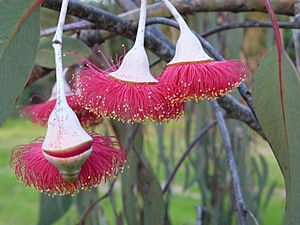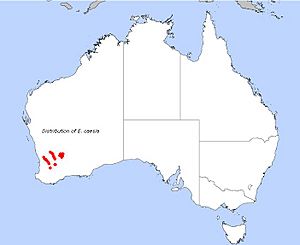Caesia facts for kids
Quick facts for kids Caesia |
|
|---|---|
 |
|
| Conservation status | |
| Scientific classification | |
| Genus: |
Eucalyptus
|
| Species: |
caesia
|
 |
|
| E. caesia, field distribution | |
| Synonyms | |
|
|
Eucalyptus caesia, often called caesia or gungurru, is a special type of tree or large bush. It's known as a mallee and only grows in the south-west part of Western Australia.
This plant has smooth, reddish-brown bark that peels off in curly flakes. Its adult leaves are long and narrow, sometimes a bit curved. The flower buds are shaped like clubs and covered with a waxy, bluish-white layer. When they bloom, the flowers have pretty pink parts called stamens with yellow tips. After the flowers, it grows fruit that looks like small urns.
Contents
What Does Caesia Look Like?
Eucalyptus caesia is a mallee that usually grows between 2 and 14 meters (about 6 to 46 feet) tall. It has a special woody swelling at its base called a lignotuber, which helps it regrow after fires.
Bark and Branches
The bark is smooth and reddish-brown when new. It peels off in long, curling flakes, which is a unique feature. Young branches are shiny red and covered with a waxy, bluish-white coating.
Leaves
Young plants and new shoots have thick, glossy green leaves shaped like hearts. These leaves are about 2.5 to 8 centimeters (1 to 3 inches) long and 2.5 to 6 centimeters (1 to 2.4 inches) wide. Adult leaves are more lance-shaped or slightly curved. They are usually 8 to 11 centimeters (3.1 to 4.3 inches) long and 1.5 to 2.5 centimeters (0.6 to 1 inch) wide.
Flowers and Fruit
The flower buds grow in groups of three where the leaves meet the stem. Each group is on a stalk about 1.5 to 3.5 centimeters (0.6 to 1.4 inches) long. The individual flowers are on smaller stalks, about 1.5 to 2.2 centimeters (0.6 to 0.9 inches) long.
Mature flower buds are oval or pear-shaped and covered in a whitish, waxy layer. They are about 1.7 to 3 centimeters (0.7 to 1.2 inches) long. Caesia mostly flowers between May and September. Its flowers have bright pink stamens with yellow tips. The fruit is a woody, bell-shaped or urn-shaped capsule. It's about 1.5 to 2.5 centimeters (0.6 to 1 inch) long.
How Was Caesia Named?
The plant Eucalyptus caesia was first officially described in 1867 by a botanist named George Bentham. He based his description on a sample collected by James Drummond in 1847. This description was published in a book called Flora Australiensis.
The name caesia comes from a Latin word that means "bluish grey." This refers to the waxy, bluish-white coating found on the small branches, flower buds, and fruit of the plant.
Where Does Caesia Grow?
Caesia grows in cracks and crevices at the bottom of granite rock formations. You can find it in scattered areas inland in the south-west of Western Australia. It grows in regions like the Avon Wheatbelt and Mallee. This species is known for being able to handle dry conditions, which means it's drought tolerant.
Caesia in Your Garden
A popular type of Eucalyptus caesia is known as 'Silver Princess'. This variety is loved for its "graceful weeping tree" shape, meaning its branches hang down beautifully. It has an irregular and flowing form.
If you want to grow Caesia, you can start it from seeds. The seeds usually sprout easily, making it a good choice for gardening.
Images for kids
See also
 In Spanish: Caesia para niños
In Spanish: Caesia para niños




